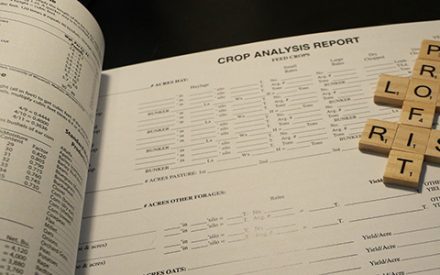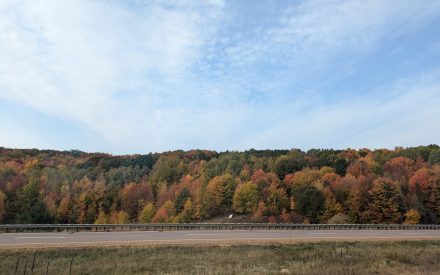Video Summary
Josh Bendorf, climate outreach specialist with UW–Madison’s Division of Extension and the Wisconsin State Climatology Office, presents the latest agricultural weather update for Wisconsin, recorded on Sept. 25, 2025.
This part of the Badger Crop Connect series covers recent precipitation trends, soil moisture conditions, temperature fluctuations, crop progress, and forecasts for the coming weeks. Stay informed on how weather patterns are shaping the end of summer and the start of fall across the state.
Resources
- Ag Weather Outlook for Wisconsin
- Wisconsin State Climatology Office
- Wisconet station locations
- CoCoRaHS Gauges and Gauge Parts
Transcript
0:05
All right, thank you, Melissa and good afternoon everyone.
0:08
Like Melissa said, my name is Josh Bendorf.
0:09
I am the Climate Outreach Specialist with the Wisconsin State Climatology Office and the Division of Extension.
0:15
And today I’ll be delivering your Ag Weather Update that we do as part of the Badger Crop Connect webinar series.
0:20
Just as a reminder, this is a smaller version of the Ag Weather Outlook for Wisconsin that we put out every week with Extension.
0:28
The most up to date version of that will be coming out either later today or early tomorrow.
0:35
So taking a look at precipitation since the last time we talked two weeks ago, it’s been really hit or miss across the state.
0:42
Some areas have seen a few inches of precipitation, others have seen less than 1/2 inch.
0:47
So it’s just kind of been luck of the draw for precipitation.
0:50
Looking back two weeks now, September 9th through the 15th, it was a pretty dry week, about 1/2 inch or less across most of the state, but there was this narrow band.
0:58
You can see it on the map here on the left of a couple inches of precipitation kind of stretching from east of Madison up through the central and west central parts of the state.
1:09
That got 2 to 4 inches just in that narrow little band across the middle part of the state.
1:15
September 16th through the 22nd.
1:17
This past, this most previous week we had most folks saw over 1/2 inch of precipitation across most of the state.
1:25
So a little bit more of an active week compared to the prior week.
1:28
And two to four inches was common in the central region.
1:31
You see that area there is the central and the west central showing up in those yellow, orange and red colors.
1:36
That’s two inches plus of precipitation and we had a few pockets of three inches or more and you see some areas there showing up in red that even topped 5 inches according to these radar estimates.
1:49
So looking at last week, it was very summer like across the state.
1:52
We had many days, most days in the south that had a high temperature topping 80°.
1:58
You can see there the map on the left that is the number of days with a max temperature of 80° or higher.
2:04
And then the map in the middle is number of days with precipitation over equal to or over 1/10 of an inch.
2:10
So we had many days that were warm, but we also saw measurable precipitation across most days, especially in the western and northern parts of the state.
2:18
We had some new record high temperature set at a handful of stations September 16th through the 19th with temperatures getting well into the 80s on those days.
2:28
The highest Wisconet temperature that we that we recorded over the past week was at River Falls and that was just under 90 degrees, 89.2 on the 16th.
2:37
And then the highest Wisconet seven-day temperature or excuse me, precipitation reading was also at River Falls and they got just under 3 1/2 inches over the seven-day period
2:47
September 16th through the 22nd.
2:51
Looking back over the last month, the last 30 days, we’ve been below normal pretty much across the board in Wisconsin except for a few pockets in the north, west, central and NW.
3:02
Precipitation totals have been on the order of 2 1/2 inches or less for a lot of Wisconsin.
3:07
And you see there’s parts in the eastern and southern parts of the state that have received less than an inch of precipitation over the last 30 days, and that’s been 50 to 25% or less of average.
3:18
Those areas on the map on the right shaded in red, but you see a lot of the map there is shaded in orange.
3:23
That’s below normal precipitation of what we would expect for this time of year.
3:28
But there were those localized areas of above normal precipitation in the west and north where totals topped 4 inches.
3:36
But looking at 2025 precipitation so far, I’ve been saying this for the past few weeks, but things are pretty close to average if we look back over the entire year.
3:46
We see the map there on the right is showing a lot of those yellow and light green colors.
3:51
Those are, that’s right, about average, you know ±10%.
3:54
So even though we’ve had some dryness, we’re not seeing any major precipitation deficits if we look at the whole calendar year.
4:03
What does this mean for soil moisture?
4:05
Comparing soil moisture, current soil moisture to last week and back one month ago, we see there were some gains at some of those locations that did see higher precipitation totals last week, especially looking at locations like Spooner and Marshfield, Arlington, Kemp.
4:23
But they’re not quite reaching levels that were they’re close to levels or they’re not quite reaching levels from back one month ago.
4:30
So things were a little bit wetter going back one month ago because like I was saying, the last 30 days have been pretty dry across most of the state.
4:37
But right now, 76 to 77% of agricultural soils in the state are reporting adequate topsoil and subsoil moisture.
4:45
And that’s pretty close to what we were seeing last week.
4:47
There’s only been just a 1% decrease in the amount of soils that are short to very short topsoil moisture, and right now that’s hovering around 20%.
4:56
So despite the dryness, we’re still not seeing any like major gains in the amount of soils that are short in moisture.
5:03
This is a soil moisture model, a satellite product showing the estimated soil moisture in the top 1m of soil and how that compares to normal. Across most of the state,
5:14
we’re seeing a near normal soil moisture conditions and maybe leaning a little bit wetter, a little bit drier in some locations, but pretty much at pretty much near normal across the board.
5:24
We see those areas in the eastern side of the state that have seen 50% or less of precipitation, normal precipitation over the last 30 days of showing up a little bit drier also in parts of the north.
5:35
And some of those areas that receives some higher precipitation tolls over the last two weeks in the central, west central part of the state are showing up as above normal.
5:46
Looking at the drought monitor, there has been, there has not been any major movement in the drought monitor this week, just a very small reduction in D0 up in Vilas County.
5:55
But right now only about 4 1/2% of the state is in D0 and we have none of the state right now showing up in any of the drought categories D1 through D4.
6:05
But I want to highlight the situation that’s going on just a little bit further to the south this just to the south of Wisconsin
6:11
we’ve had some very rapid drought intensification in states like Missouri, Illinois, Indiana and Ohio that have been very dry over the last month.
6:20
This is showing the map on the left is showing the current drought severity and coverage.
6:24
The map on the right is showing the eight week change.
6:27
So how much drought has intensified over the last eight weeks or so.
6:32
We see that a lot of this drought has developed just within the last two months that going back to the end of July, most of the region was not in drought.
6:40
But since then we we have areas now that are in as drought categories as high as D3.
6:46
And a lot of this is due to the that area seeing in some cases their driest August on record.
6:52
You see the map there on the left, those areas that are in medium to darker brown are about the top within the top ten, top five driest Augusts on record.
7:02
And that was pretty common from Missouri over through the western parts of Pennsylvania.
7:06
You see here in Wisconsin, you know, even though we’ve been dry over the past couple weeks, we’re coming out of an August in the south that was wetter than normal.
7:15
So, so far, drought has not intensified here in Wisconsin, but just to the south, things have gotten pretty bad.
7:21
Turning now to temperatures, over the last seven days, things have been well above average, in some cases much as 10° above normal.
7:29
And in the last 30 days, within the last 30 days, things have been a little bit right around average on the western side of the state to a couple degrees below average
7:38
further east. Corn and soybean progress so far, things are running a little bit behind our 30 day, excuse me, our five year average, just a couple days behind average.
7:51
Corn denting right now is at 82% complete in Wisconsin field and soybean leaf drop is at 46% complete.
7:58
And right now harvest for both crops is being reported as 1% complete.
8:02
So things are just now starting to get underway. Condition
8:06
overall, things are still looking pretty good, 80 to 81% good to excellent from corn to soybeans.
8:11
But you can see just to the south there in states like Illinois, Indiana, Ohio, where they’re having dealing with drought that conditions are much worse in those areas.
8:21
Looking now to the next seven days for precip, the map on the left there looks pretty white and that’s because we have a very dry week forecasted for the state.
8:29
Maybe just some very light showers in the in the eastern and northern parts of state, but overall, it’s looking like a very dry week across the board.
8:39
Looking at 8 to 14 days out.
8:42
As we get into the first week or so of October, temperatures are very likely to be above normal.
8:47
You see the map there on the left showing up at those dark orange colors.
8:50
That’s a high probability to have above normal temperatures and precipitation is more of a mixed bag with most of the state leaning towards near normal area shaded in gray, maybe a little bit below normal in the far southeast and a little bit more chance for above normal for those of you in the far northwest part of the state.
9:09
30-day temperatures and precip.
9:11
These were the outlooks for October released last week Thursday.
9:16
Right now there’s equal chances across most of the state.
9:19
We can’t say with certainty what temperatures or precipitation are going to because they’re equal probabilities, but there is a slight lean towards above normal temperatures in the far southern part of Wisconsin.
9:32
Similar story for fall to early winter outlooks, equal chances for precipitation statewide with a slight lean towards above normal temps for most of Wisconsin and with some more uncertainty for the far north.
9:46
And so with that, that’s all I have for you today.
9:49
If there are any questions, I will be happy to take those or if there’s any in the chat, I will answer those.
9:54
Thank you.
Badger Crop Connect
Timely Crop Updates for Wisconsin
Second and fourth Thursdays 12:30 – 1:30 p.m.
Live via Zoom

 ▶ Fall 2025 Financial Assistance for Producers
▶ Fall 2025 Financial Assistance for Producers ▶ Fall 2025 Ag Policy Update
▶ Fall 2025 Ag Policy Update ▶ Fall 2025 Corn and Soybean Market Outlook
▶ Fall 2025 Corn and Soybean Market Outlook ▶ November 6 Ag Weather Outlook for Wisconsin
▶ November 6 Ag Weather Outlook for Wisconsin


